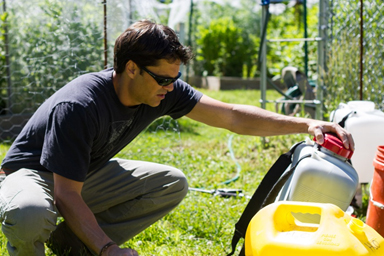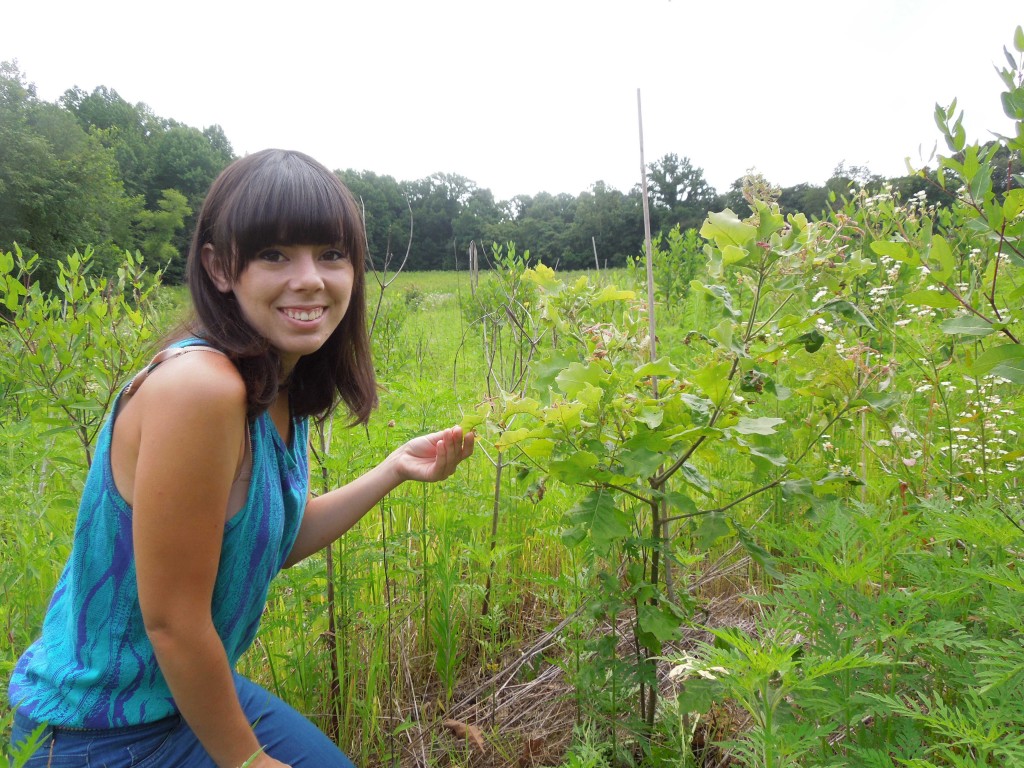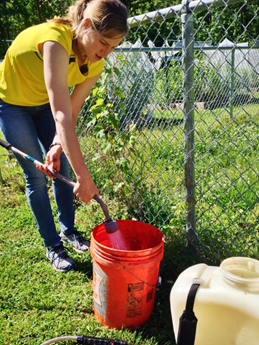by Dejeanne Doublet, terrestrial ecology intern
Ecological research usually doesn’t evoke thoughts of Stephen King horror movie scenes. Working with plants and animals in the open air shouldn’t provoke nightmares of being drenched in blood. Green is a very different color from red.
However, fellow intern Megan Palmer and I learned on our first week that sometimes, just sometimes, Stephen King references are the best way to describe a day’s work in the field. During our first days at the Smithsonian Environmental Research Center, Palmer and I were asked to do something that made my non-red-meat-eating stomach turn.
“Go spray pig’s blood on all our trees,” Dr. John Parker, the lead terrestrial ecology scientist and our boss told us during one of our first meetings with him. He was referring to the 24,000 tree saplings planted last summer as part of a 100-year experiment on biodiversity, fittingly called BiodiversiTree.
Lots of trees require lots of land. Luckily, there was more than enough cropland within SERC that was previously used to grow corn. Parker converted this used-up land, strained from the demands of nurturing a nonnative monoculture, back to a forest of native and common tree species found in this area. Some plots represent low-diversity forests with only one or four species; others represent high-diversity forests with up to a dozen different species. The long-term goal is to create a place where future ecologists can study the differences between a forest with high diversity versus a forest with low diversity. For now, Parker and his team plan to assess how converting farmland back to native forest will affect water quality of a nearby watershed leading into the Chesapeake Bay.
Before spraying the pig blood on thousands of trees, we first had to make it. At the risk of this project appearing like an actual horror flick, the making of the pig’s blood is not nearly as gruesome as it may sound. It’s basically a mixture of powdered blood and water, which oddly resembles brownie batter when mixed together.
The purpose of spraying blood on the trees— besides the obvious desire to be the creepiest lab group in the research center— is to keep away hungry deer that like to munch on small, easy-to-reach plants. While the smell of blood may simply repulse us humans, it will scare away deer. For deer, the smell of blood signifies death; death signifies possible predators in the area; predators signify the need to get the heck out.
Around here, deer have been a major source of headaches for researchers unable to keep them off their study sites. Parker is not one to take any chances on having deer eat the hours upon hours of labor it took to plant 24,000 trees. Instead, he saw the perfect opportunity to get his new interns outside taking matters into their own hands. And that we did.

John Parker, lead ecologist of the Terrestrial Ecology Lab, fills a spray backpack with pig blood to repel deer. (Dejeanne Doublet/SERC)
On our first day here, Parker joked that half of an experimental plant ecologist’s job is landscaping. We soon learned he wasn’t quite joking. Besides strapping on a 4-gallon plastic backpack containing blood and spraying thousands of trees with it, we spent our first week weeding and mulching the common garden used to grow spare trees to replace any dead trees in the plots. Within a couple of days of being in the field, I gained arm muscle I never knew I was capable of having. I was stung by a bee for my first time and pinched off the first tick I’ve ever had on me. Parker also joked that he got a Ph.D. so that he can mow grass for hours on end. That wasn’t quite a joke either. He spent afternoons right beside us, swinging around a machete and mowing the ruthlessly growing grass around the garden, literally trying to give the trees a little room to grow.
“Science is hard work,” he said one afternoon. However, at the end of our week-long landscaping “orientation,” I couldn’t help but feel lucky. While some of my post-grad friends slave away at desk jobs, I was spending my week outside helping young trees survive to see another year, discovering strange-looking insects, gaining some sweet upper-body strength and working within a new landscape towards the advancement of a better understanding of ecology and biodiversity. For that, I will gladly go home with blood on my hands.



